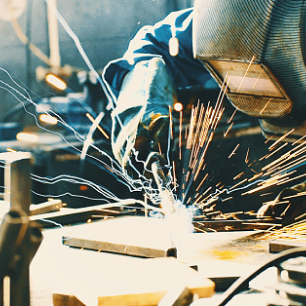Jump to:
Welding in Earthquake Country? There’s a Code for That.
“I feel the earth move under my feet…” Carole King sang it, but for structural engineers and fabricators working in seismic zones, it’s more than a catchy lyric—it’s a design challenge. That’s where AWS D1.8/D1.8M:2025 - Structural Welding Code — Seismic Supplement comes in.
This newly updated supplement to AWS D1.1/D1.1M:2025 - Structural Welding Code — Steel, is now available for purchase and contains the specific welding requirements used in Seismic Force Resisting Systems (SFRS)—the systems designed to absorb and dissipate the energy from earthquakes. If a contract adheres to D1.8, this edition is key for success.
What Is AWS D1.8? A Seismic Supplement, Not a Standalone Code
AWS D1.8 isn’t a standalone code. It’s a supplement to AWS D1.1/D1.1M, designed specifically for projects where seismic performance is a factor. If a structure is expected to ride out the rumbles, D1.8 provides the additional requirements needed for welding in those high-stakes conditions.
From demand-critical welds to continuity plates, from inspection criteria to documentation, it’s all laid out here. The supplement aligns with the AISC Seismic Provisions, providing guidance for those involved in the design, fabrication, qualification, and inspection of welded joints in seismic applications.
Why AWS D1.8 Is Essential in Earthquake Country
In many cases, D1.8 isn’t just a “nice to have.” It’s mandated by job specifications or structural design documents. That means everyone from the design engineer to the fabrication shop needs to be operating from the same page—literally.
This isn’t about overdesigning—it’s about matching the welding process to the dynamic demands of earthquake-prone regions. D1.8 helps bring consistency to fabrication, inspections, and qualification requirements when seismic performance is on the line.
What’s New in the 2025 Edition
The 2025 edition of AWS D1.8 has been revised and updated to align with the newly released AWS D1.1/D1.1M:2025. This means a smoother, more consistent experience for users working across both codes.
Changes include:
Clause 1: Aligned the Engineer's responsibilities with AISC 341. Clarified that when a WPS is qualified by testing, a PQR needs to be submitted with the WPS in conformance with AWS D1.1/D1.1M and D1.8/D1.8M.
Clause 4: Clarified that the location and connections of doublers shall be specified by the design drawings. Provided all the requirements of D1.8/D1.8M, D1.1/D1.1M, and the details of Figure 4.3 are met for welds at the fillets of hot rolled shapes, testing is not required to qualify the joint geometry.
Clause 6: Added a provision for the heat input limits and for alternative to filler metal production lot testing for WPS's qualified by test. Clarified the locations where notches or grooves in the weld access hole shall be removed by grinding. Added new subclauses for restoration and repair. In Table 6.4, additional electrode classifications for AWS A5.18/A5.18M were added.
Annex A: Provided clarification that the welding assembly can be preset prior to welding.
Seismic Requirements Are Serious
Let’s face it—Mother Nature doesn’t send calendar invites. But when structures are designed and welded according to D1.8, they’re better prepared to withstand seismic events without catastrophic failure.
Whether you're an engineer specifying the code, a fabricator building to it, or an inspector verifying compliance, AWS D1.8 is the go-to supplement when seismic conditions are part of the equation.
Get the latest edition of AWS D1.8/D1.8M:2025 today and stay grounded, no matter what’s shifting beneath your feet.
The PDF edition is now available through the AWS Bookstore, with hard copies expected within 60 days.


